Image Credit: eMonitor data, Alex Wilson
Image Credit: eMonitor data, Alex Wilson This graph shows the electricity consumption profile of our HPWH on March 4th and part of March 5th. Consumption on the 5th is in green; consumption on the 4th in gray.
In last week’s blog I wrote about the GE GeoSpring heat-pump water heater in our new house — first, why we decided to go with electric water heating over solar thermal (since we use solar to generate as much electricity as we will consume), and then how we decided on a heat-pump water heater instead of one of the other electric water heating options. This week, I’ll get into a little more about heat-pump water heaters and some of the issues that come into play when installing them in cold climates.
To review from last week: a heat-pump water heater (HPWH) extracts heat out of the air in the room where it is located to heat the water. I’ve described previously the basics of heat pumps and how they perform this counterintuitive process of taking heat from a colder space and heating something that’s warmer. Suffice it to say that that process (relying on the vapor-compression or refrigeration cycle) works and has been used for a long time in refrigerators, air conditioners, and heat pumps used for heating and cooling houses.
Cooling the space where the appliance is located
What this means for a HPWH in a house like ours, is that it cools the space where it is located. That’s a good thing in the summer — free air conditioning — but in the winter it’s not such a good thing. That’s especially the case in a cold climate in a house without a standard heating system.
In a typical New England house that has a furnace or boiler in the basement producing a lot of waste heat, a heat-pump water heater can use some of that waste heat and it’s not really very noticeable. The less efficient the heating system, the less noticeable is the effect of the HPWH.
But we don’t have a heating system in our basement. As a result, our HPWH cools the space. With the cold weather we’ve had (as I write this, it’s about 2 below), our basement has stayed pretty cool: typically 50°-54°F, though with the exceptionally cold weather we had a few weeks ago during a time of heavier hot water usage, the temperature dropped as low as 47°F. Right now, it’s 52°F.
I think our basement temperature would be considerably lower if my wife and I used a lot of hot water, but we’re pretty frugal, and my wife swims a lot, so she often showers at the pool where she swims.
Robbing from Peter to pay Paul
In cooling the space where it is located, a HPWH makes the heating system work harder. In our house the heating system is a single minisplit air-source heat-pump; the indoor cassette is mounted on a first-floor wall. That system delivers heat to the basement through the uninsulated floor and through the basement door, which we usually leave closed, but sometimes leave open.
We also have a fan and ductwork at the top of our stairs so that, if we need to, we can pull warm air from the heated space in the house and dump that into the mechanical room in our basement. Eli Gould suggested this as a backup in case the basement got too cold. We haven’t used that fan, though, because it’s too noisy.
So our 18,000 Btu/hour Mitsubishi air-source heat pump has to work harder (and use more electricity) because it’s also indirectly heating our water. With the really cold weather we’ve had since moving into the house in early January, our air-source heat pump has been working pretty hard to keep up. And I think the HPWH has contributed to our first floor being a little cool — especially near the floor. (Having heated mostly with wood for 30-plus years, this has been a very minor issue, but cooling our basement with the HPWH may be keeping our first floor a little cooler than I would like — especially near the floor level.)
My friend Lester Humphreys in Brattleboro, who also has a HPWH in his basement but has an oil-fired boiler there as well, has done some back-of-the-envelope calculations to estimate how much oil he’s using for his water heating, and he asked me to look over his numbers:
“I calculated the loss from our living space through the floor to the basement using the formula Area x 1/R x delta T; I figure our heat-pump water heater lowers the temperature in the basement by about 3 degrees, our wood floor has an R-value of 2.75, and the basement ceiling is 1,217 square feet. This gives me heat loss of 1,314 BTU per hour. Running 6 hours a day (probably a little high), with a delivered heat efficiency of 70% for our oil system, this equals 2.4 gallons a month (about $9), which is not bad.”
With our hot water usage, the electricity consumption directly by the HPWH isn’t that great: 56 kilowatt-hours (kWh) in February — or about $8 worth at 15¢ per kWh, which is Green Mountain Power’s current residential electric rate. Consumption averaged a little less than 2 kWh per day in February, jumping to over 8 kWh one day when both of our daughters were visiting from out of town and we had to switch the water heater to the “Boost” mode (in which an electric resistance heating element supplements the heat-pump mechanism).
Along with that 56 kWh used by the HPWH, though, some of the 814 kWh used in February by our minisplit air-source heat pump heating system (about $125 worth), was for water heating. I haven’t calculated what our total water heating cost was for February, but that should be possible to do.
Slow recovery
Another thing to keep in mind is that HPWHs have a quite slow recovery rate; I think that ours recovers at a rate of about 8 gallons per hour. This is why larger water heaters often make sense with HPWHs, though I thought a 50-gallon model would be all right for our usage.
In mid-February, though, our younger daughter from New York City and our older daughter and financé from California were visiting, and we had a party. We still might have been all right with hot water, since we have WaterSense plumbing fixtures and a high-efficiency dishwasher, but our younger daughter decided to take a bath after we had all done a lot of party prep. She ran out of hot water before the tub was all the way filled.
Fortunately, most HPWHs, including our GE GeoSpring model, allow you to change the mode. I normally operate the water heater on Heat Pump Only mode, but switched it to Boost mode for a few hours that Saturday.
The jump in power draw was dramatic (shown by my eMonitor). In Heat Pump Only mode, the power draw peaks at about 500 watts, but that jumped to 5,000 watts in Boost mode.
Noise
The other issue to consider with HPWHs is that they have fans and compressors that are noisy. I don’t think I would consider a HPWH if we didn’t have a basement and had to place the water heater on the first floor. We have fairly good acoustic isolation between our basement and first floor — and the water heater is in a mechanical room to which we can retrofit ceiling and wall insulation if the noise proves annoying.
So far, the noise isn’t very noticeable, but in the summer (when the air-source heat pump is unlikely to be running) we may find that we can hear the water heater — in which case I’ll probably insulate the mechanical room. Noise did play into our product selection; when I was researching options, the GE GeoSpring was the quietest HPWH I found.
The bottom line
In summary, we’re happy with our heat-pump water heater, despite the cold climate and the fact that we don’t have a waste heat source in our basement. I’m guessing that, for half the year, we’ll save at least 60%, compared with a standard electric water heater, while we’ll save only 10-20% in the cold months. Homeowners with a waste heat source in their basements will do better.
Alex is founder of BuildingGreen, Inc. and executive editor of Environmental Building News. In 2012 he founded the Resilient Design Institute. To keep up with Alex’s latest articles and musings, you can sign up for his Twitter feed.
Weekly Newsletter
Get building science and energy efficiency advice, plus special offers, in your inbox.

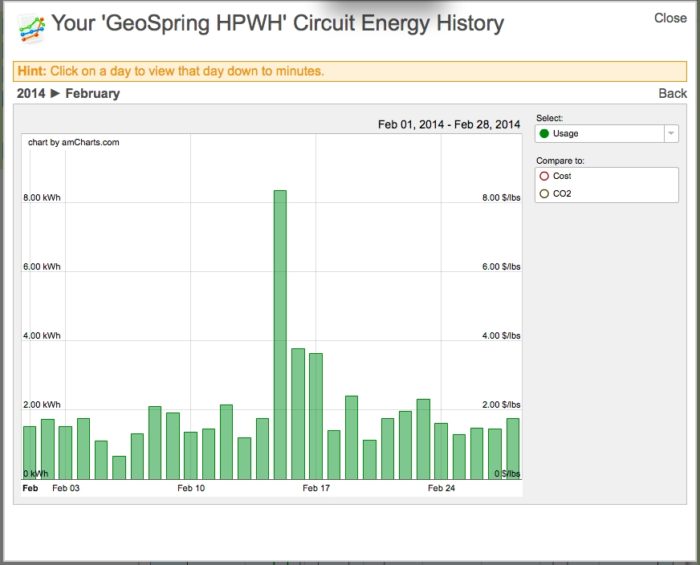




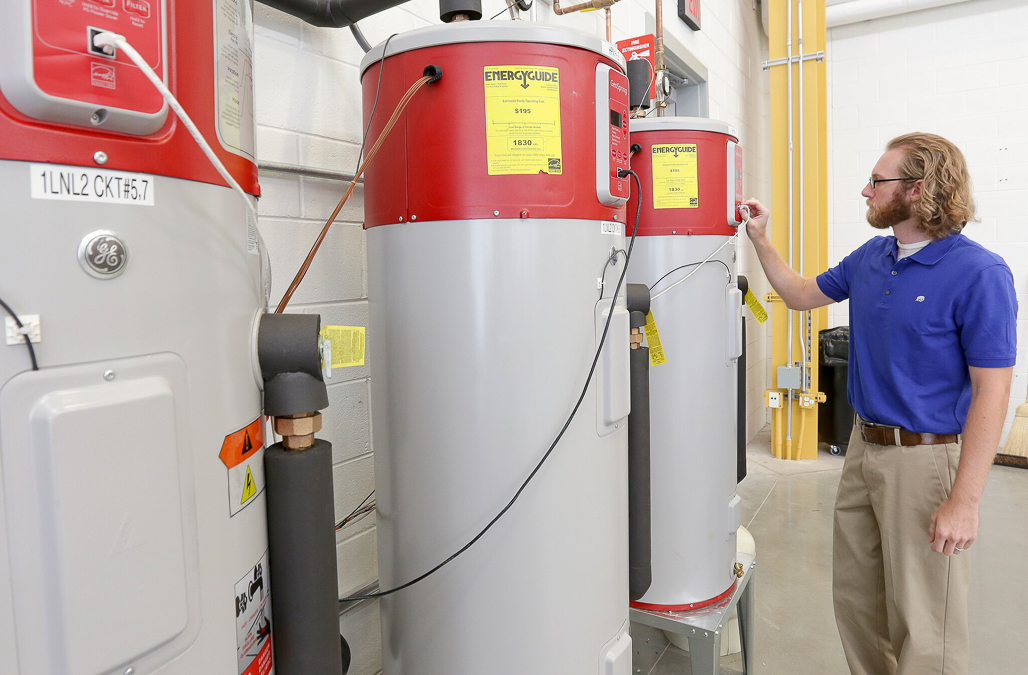
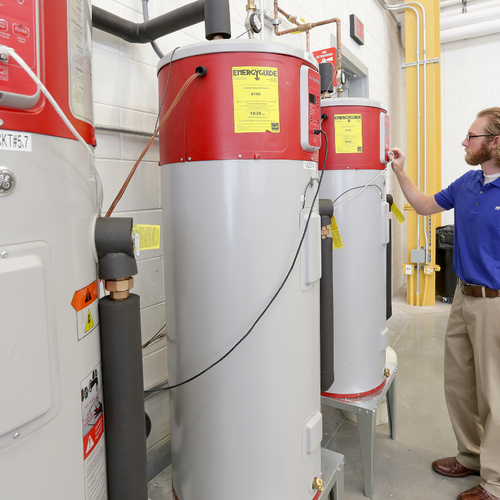
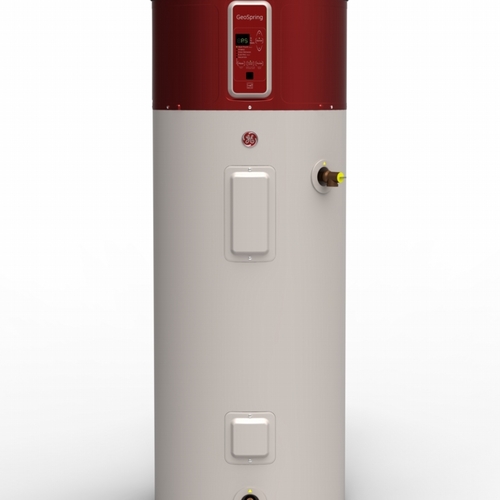
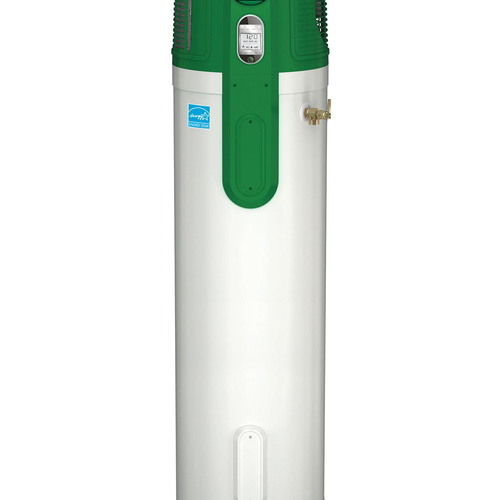






13 Comments
when it's cold... and dry
Hi Alex,
I, too have the Geospring (had it for a few years now.) One thing I have noticed - especially this past winter - is how it really struggles when the basement is extraordinarily dry. We do use a humidifier with our home's heat pump, and try to keep the moisture level within a comfortable range in the house, but there are always a few days when the Geospring just cant extract enough heat out of the air, it seems. So we kick it into high demand mode. These days are not the coldest days we have, but typically the driest, it seems.
Have you done any measurements of the RH around your Geospring, by any chance? I guess it would be tough to separate the data, but I'd be real curious how it performs on cold-humid days vs. cold-dry days. I only think this because there are some days in the shoulder seasons where my basement is no colder than it is right now, but there is more moisture in the air - a primary ingredient toward the water heater's performance.
Matt
I would disagree with calling
I would disagree with calling heat lost in an unfinished basement. I understand why you do (presumably because you aren't using the space) but every BTU that is generated and dumped INSIDE the envelope contributes to the total heat in the building. An unfinished basement that is getting heat through duct leaks etc is saving heat that would otherwise come from the upstairs via conduction and convection. The only way the heat in the basement would truly be "waste" is if the basement were outside the envelope of the house.
That being said, pumping "excessive" heat into a basement that is not used as living space is an inefficient way to heat. One can imagine a scenario in which so much heat is "lost" into the basement that its temperature is higher than the main living space causing you to demand more run time than you otherwise would but even then that excess heat is not "wasted". It would eventually be distributed to the remainder of the enevlope just in a very uncomfortable manner for the occupants. Even if the basement were uninsulated, the heat "lost" into that space wouldn't be wasted. If it hadn't been "lost" into the uninsulated basement, heat from the upstairs would have been.
AT the end of the day, it really isn't any different than your refrigerator taking heat out of the frig and dumping it inside your house in the summer which you then have to remove with your airconditioner. Its just the scale thats different.
Comparative carbon footprints
Alex and others,
I'm curious about the comparative carbon footprint of water heating options for someone who does not have a solar array, and does not expect to be getting one any time soon. Using Green Mountain Power as an example, I get a conservative value of 11% of the electric supply coming from fossil fuels, which for sake of argument I'm treating as all natural gas. I get that as follows:
Green Mountain Power gets 44% of it's electricity from wholesale purchases off the ISO-NE grid, at least that's what it did in 2013. The rest of its supply comes from (more or less) low-carbon sources. In 2013, an average of 51% of ISO-NE's electricity came from fossil fuel generators, almost all of that being from natural gas. If we are generous and treat this as all natural gas, and assume that all the gas plants are combined-cycle plants (which they are not) with 60% thermal efficiency, and take off 10% for line losses, I think we're looking at the following situation... 44% x 51% x 50% = 11% of the HPWH's electric supply is attributable to natural gas. In reality, the HPWH's supply will be more fossil-intensive than that.
I'm finding it difficult to think through the situation. I think maybe what this means is something like: the HPWH paired with a propane space heating system has a smaller carbon footprint than a propane hot water heater if the parasitic impact of the HPWH on the space heater is less than ~15% (bumping up the 11% value above to account for the propane water heater being less than 100% efficient).
I really don't trust this--my head is swimming with different ways of drawing the lines between the different factors involved, and I can't settle on something that seems convincing.
Here's an alternative solution: for every gallon of extra propane burned by the space heating system due to parasitic effect of the HPWH, the carbon footprint of the HPWH is lower than for a direct-fired propane water heater IF... what? I repeat: my head is swimming!
Don't forget...
... that half the heat in the hot water is being sourced by the -FE18 mini-split at a seasonal average efficiency of 300%, but higher efficiency during the daytime hours when temps are higher, only ~200% efficiency when it's +5F or colder outside. Or were you considering staying on propane, even though heating with ductess is both cheaper and lower-carb (and not just for high-R houses.)
The ISO-NE grid-efficiency of their 51% fossil mix is really more like 50%, not 60%. Grid losses are more like 7%, from generator to load not 10%. The fossil power generator kwh going onto the ISO-NE grid ARE primarily combined cycle gas- the gas-fired peakers operate at very low capacity factors, and most of their operation is in the summer, when the heating system is off , the room temps are higher, giving the heat pump a higher COP, and the heat for the rest is coming from nature, not the -FE18.
Over the lifecyle of the hot water heater it's carbon footprint is likely to improve, as more and more distributed PV and wind come on line. We're still at the leading edge of the PV tsunami that is going to sink some utilities if they don't adjust their business models fast enough (as is happening in Germany today.) The Q4 2013 weighted average cost for grid tied PV in the US was under $3/watt, all-in costs before subsidy, and is still trending downward. By Y2020 it's widely predicted to be half that, which has a lifecycle cost well below the residential retail prices of electricity in New England. So whatever mix you ascribe to the ISO-NE grid today, it'll be significantly lower-carb by 2020, halfway through the warranty period of the GeoSpring.
And that's not even looking at the growing wind sector in New England that is also just getting started. Though wind is expected to be more expensive on a lifecycle basis than $1-1.50 PV it will be cutting into the capacity factor of the combined cycle gas burners in a serious fashion, not just the peakers
It's worth downloading the full version of this document:
http://blog.rmi.org/blog_2014_02_25_will_the_electricity_grid_become_optional
See also this recent bits of bloggery:
http://www.greentechmedia.com/articles/read/u.s.-solar-market-grows-41-has-record-year-in-2013
and this:
http://www.greentechmedia.com/articles/read/this-is-what-the-utility-death-spiral-looks-like
Drainwater Heat Recovery
Hi Alex: you mentioned est. average electricity savings of 35%-40% p.a. for the HPWH vs. a conventional electric HW heater; also you plumbed a separate 2 inch graywater drain pipe. Assuming sufficient vertical space between basement ceiling and sewer exit drain is available: an R2-60 PowerPipe drainwater heat recovery device with 46% heat recovery is available at a big box retailer for $599 (free shipping to home). A longer R2-72 model has a 53% nameplate heat recovery, see http://www.renewability.com It might be possible to duplicate the est. 35%-40% annual electricity savings with a drainwater heat recovery device. Ancillary advantages include: lower initial capital cost; better durability since a PowerPipe should outlast several water heaters; essentially zero maintenance; less noise; less strain on the mini split heating system during cold weather; less wear on the hot water heater; faster hot water recovery. Of course, you almost surely have very low batch type hot water usage via a CEEE Tier 3 dishwasher and Tier 3 horizontal axis washing machine, already.
COP 3 no way.
Dana, I heat my
COP 3 no way.
Dana, I heat my home for far more time when mini splits operate at COP 2. I think for me seasonal COP 3 is fantasy.
Aj
And HPWH warm humid climate for the hearing impaired is reality.
Dana, I win the bet!
I bet myself $1 that you would provide an answer. Now to decide where to spend my winnings... :)
'Tis true that the grid is all but guaranteed to become lower and lower carbon over time. I'm less convinced that there's a tidal wave of solar and wind in the near'ish future. I not talking about growth rates, since it's pretty easy to have a high growth rate when you start from zilch. I'm talking meaningful fraction of the grid supply, and I don't see that happening for a bunch of years yet. That's a bet I'll be happy to lose.
Personally, I'll be getting solar in the next couple of years, as soon as I can get myself involved with a decent community array or group net meter off of a neighbor's system. Our home won't fly as host for panels. But I asked out of curiosity. I know the heat pumps are tops for efficiency on site, but I wanted a good walk through the numbers to be better convinced that this stuff really is lower carbon from start to finish.
And frankly, I'm still not clear. You're the engineer: is there a back of the envelope formula that will show us the threshold at which an HPWH drawing parasitically off of the space heater is carbon better or carbon worse?
COP = 3 totally WAY, AJ! It's been measured.
Review the measured performance of the Eastern Idaho cluster in this document (particularly the discussion of that cluster in the addendum .:
http://neea.org/docs/default-source/reports/ductless-heat-pump-impact-process-evaluation-field-metering-report.pdf?sfvrsn=31
On p. V of the addendum (p.119 in PDF pagination) they note:
"The field monitoring in eastern Idaho demonstrated that DHPs performed well even in cold climates. The measured, annual, coefficient of performance (COP) at the 10 new sites was found to be 3.0. Further, the instrumentation showed that the DHPs continued to operate at outdoor temperatures as cold as -15 ̊F, providing 100 ̊F air to the house at a COP near 2 in these conditions."
In fact they rounded up the numbers. The Idaho Falls/Eastern Idaho cluster field monitored in-situ for efficiency in reality "only" averaged a COP of 2.96, not 3.0. :-)
They were all Mitsubishi MSZ-FE12NAs (same series as Alex's), and all 2010 vintage or earlier. The climate in Idaho Falls is colder than southern VT where Alex Wilson lives, and the cooler temp takes a toll on efficiency. Alex's unit is the -FE18, which has a slightly lower nameplate HSPF than the -FE12, but newer versions have all seen incremental efficiency improvements since 4-5 years ago too.
Also, the units in Idaho Falls were all under-sized for the whole-house loads (whereas Alex's is right-sized for his high-R house) and were all retrofit auxiliary heat, thus likely to spend more hours at max-speed. Running at max speed also has a negative impact on efficiency, as seen in the bench testing data on an even older -FE12 than those monitored in Idaho Falls.
http://www.nrel.gov/docs/fy11osti/52175.pdf
Note also that even at -10F out doors at max speed the -FE12 is delivering a COP of about 1.8 (comparable to the -15F performance of the field tested units in Idaho) as seen in figure 9, on p.14 (p.22 in the PDF pagination).
Add it all up all the factors and Alex Wilson's 2013 vintage -FE18 is likely to be averaging a COP slightly BETTER than 3.0.
At the napkin-math level of precision we're talking here, 3 is the closest whole-number it's going to be performing near- I doubt it'll do better than 3.5, but if it's averaging even as low as 2.8 something is wrong with the unit.
I didn't really answer Jonathan's question...
...so did he really win the bet? I just pointed out that he had neglected to account for the carbon of the fraction supported by the mini-split, and that there is no simple answer.
Some of the off-peak kwh ( which is when most of the space heating power is used) on the ISO-NE grid can even be carbon-negative or carbon zero, since it may be applying some use to power that would otherwise dumped rather than having to incur the costs of spinning up a cold powerplant (or nuke). The time of day that the hot water heater is recovering is less likely to be off-peak though, and could have a carbon footprint higher than the ISO-NE average.
I too was skeptical about the prospects of a distributed PV tsunami until last year, watching what happened in Hawaii. When the regulatory environment allows net-metering at retail and the lifecycle cost of PV is well under the residential retail rate, there is enough margin for third party ownership of PV VERY profitable, and makes it very easy for the home owner with the sunny roof to get into the game. There are also $0 down loan money options becoming availble that is an even better deal the than the third party ownership or lease options. It only happened in Hawaii first due to the fact that most of the central generator grid power is running #2 oil, making it some of the most expensive grid power in the US at about 36-37 cents/kwh. (See: http://www.eia.gov/electricity/monthly/epm_table_grapher.cfm?t=epmt_5_6_a )
At about $6-7watt all-in cost, with federal and local incentives this became very attractive for 3rd party owners or homeowners with the credit or cash to buy in, and at $4 it became super-compelling, and as the price crashes further, it's beyond a no-brainer and becomes a landslide. In Hawaii they're now scrambling to manage the back-feeding of the grid from all of that distributed solar in several areas, where the mid-day output is well in excess of the mid-day load for whole neighborhoods and subgrids, leading to overvoltage conditions and other problems. This is manageable and affordable, one of the solutions is distributed grid-storage (typically batteries) to soak up the excess and shave the early PM peak load, but there's more to it than that. The only reason that it's a scramble in Hawaii is that it happened so they didn't plan for it. In CA (where the retail residential rates are 16-17 cents/kwh) they are trying to stay ahead of that, wave, with statewide mandates for gigawatts of grid storage of multiple technologies, and on both sides of the meter.
It's now looking like rooftop PV in the lower 48 will average a bit under $3/watt in 2014- panel costs are slightly up, but the inverter and soft-costs are still falling pretty quickly. The $1.50/watt goal for 2020 looks more than realistic, it may happen sooner. But even a $3/watt at New England power rates that makes it a pretty easy way to save some money even for the lease options where third party owner ship is allowed by regulators (which is basically all of the ISO-NE region: http://apps3.eere.energy.gov/greenpower/onsite/solar_financing.shtml ) this is a rising tide that will keep on coming, and PV could easily be well into a double-digit fraction of the all kwh on the grid before Alex's warranty is up.
Small scale solar at $3/watt has become quite bankable- it's becoming ever more easy to get $0 financing, which will cut into the third party ownership model significantly over the next decade, since it beats the lease deals hands down in most higher cost markets, and there's investor & bank money chasing it already:
http://solarlove.org/solar-leasing-worst-option-going-solar/
https://www.energysage.com/market/estimate/enter/
Cape Wind recently has gotten more financing, and is looking like a solid "go" after more than a decade of chasing off legal challenges, and there is other offshore wind leases that have been taken in the ISO-NE region. At least some of this will be feeding the grid before 2020 too. Total demand in this region is flat to falling- that may change if electric cars take off in a big way. The thin edge of that wedge is here now, but the rising tide won't begin to happen until lithium-ion is under $200/kwh, which only the most optimistic are saying will happen before 2020. We'll see.
Charts to me point to less than 3 COP
For myself heating is not a need when the charts are showing COPs of more than 3. So the annual average I am thinking for my use would not be close to 3. I do agree that 2 plus is worthy.
My area has a terrible track record to do with heat pumps. Cold homes, cold air, electric back up kicked in, and maintenance costs.
Someday I may know of a hundred great performing local mini split homes,but that day is not here yet for me at least. Have to ask around a bit, and look for the telltale compressors.
HPWH Heat Stealing Carbon...
Jonathan,
To answer your question, remember that the heat delivered from a HPWH can be split into the electrical load and the space heat load as: a fraction 1/COP comes from the grid, and 1-(1/COP) comes from space heat (assuming the HPWH is entirely inside a well insulated conditioned space). If the space is semi-conditioned, like an unheated basement, you should derate the second factor by some amount---you can reduce the temperature of the basement (and losses to the earth) without increasing space heating loads in a BTU for BTU way.
In a cold basement, a HPWH is prob COP = 2 (conservatively, averaged over a heating cycle), so figure half of the energy used comes from the grid, and half from the space in the winter.
In a warm climate, try to figure out the effect of space cooling reducing your AC loads.
ISO-New England's grid mix in quasi-real time
Even though the annualized mix of all ISO-NE power in recent years has been ~50% gas-fired, the daily/monthly/seasonal fractions vary by quite a bit due to the absolute power load and the per BTU price variations of nuke/coal/gas, etc. The grid operator in this case has a web-widget page showing (amongst a bunch of other data, including the average levelized market price after grid losses) the grid mix over the most recent 5 minute interval:
http://isoexpress.iso-ne.com/guest-hub;jsessionid=66C85B665DFB116ABFFFDE05E6F6E06C
In the past few days the mid-day mix has been about 1/3 gas, 1/3 nuke, 1/6 coal, 1/6 renewables.
Broken down by source the renewables are roughly 1/3 hydro, the rest primarily biomass (both wood and trash-to-energy feedstocks), but a decent fraction comes from wind on windy days. Over the past 5 minutes wind was delivering a bit more than 1% of the total grid power in the region, a still tiny but growing slice. PV is expected to catch and pass wind in total annualized output in this region within 2 years, despite the fairly high growth rate of wind.
The carbon footprint of the coal fraction exceeds that of the gas fraction due to the limitations of thermal-coal having only ~2/3-3/5 the thermal efficiency of the gas fired mix, and ~2x the carbon per BTU as a fuel source, so at the mix over the past 5 minutes the carbon per-BTU is about the same as running the whole grid on 55% thermal efficiency combined cycle gas. Overnight the nuke fraction will dominate, since the load falls dramatically but nukes can't be throttled back and ramped up quickly the way c.c. gas can, making the midnight to 5AM load significantly lower-carb than the mid-day plateau or the business-lunch peak.
So... the carbon footprint of your shower depends a lot on the hour of the day, not just the grid-mix-du-jour, and certainly not the annualized average. But if you really wanted to know, you could peek at the 5-minute snapshot before stepping into the shower.
Pairing Refrigerator hot air with HPWH cold air
The refrigerator in our new home will back up against the adjoining wall of the 6ft 6" x 6 ft 6" mechanical room where our GE GeoSpring HPWH will be located (with louvered door). Makes sense to me that I could vent the refrigerator's warm air into the mechanical room. The two condenser's could keep each other happy.
Our mechanical room will also house a ceiling mounted UltmateAir energy recovery ventilator. Does anyone see any problems with the HPWH and ERV both being located in the same small space?
Cabin will be heated by air source heat pump.
https://www.greenbuildingadvisor.com/blogs/dept/qa-spotlight/designing-hvac-system-cold-climate
Log in or create an account to post a comment.
Sign up Log in